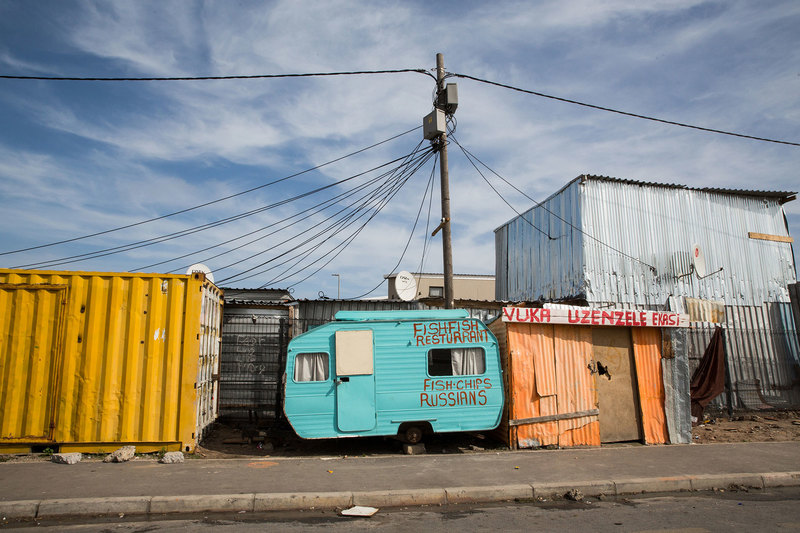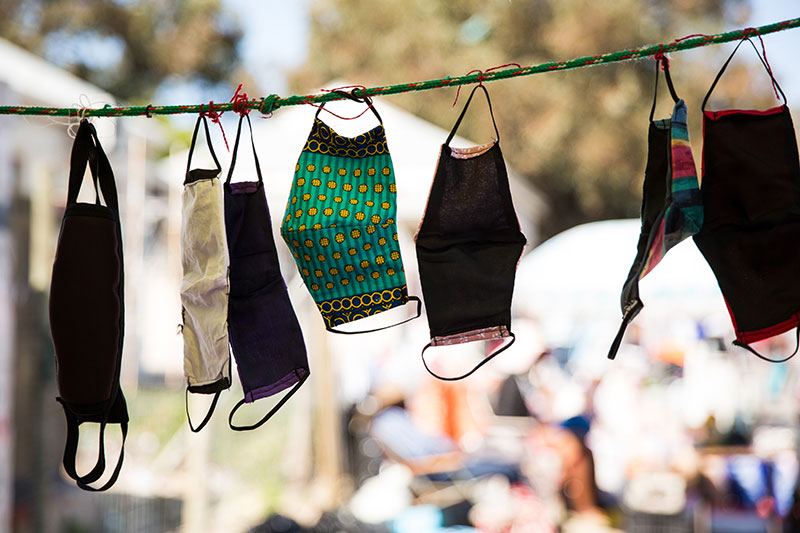Pandemic praxis: adapting research methods within COVID-19 constraints
17 March 2021 | Story Ambre Nicolson. Photos Samantha Reinders. Read time 6 min.
The University of Cape Town’s (UCT) African Centre for Cities’ Nourished Child project is using a mix of photography and online messaging technology to continue doing fieldwork during the COVID-19 pandemic.
COVID-19 reached South Africa around the same time the Nourished Child project team was preparing to embark on a series of immersive group walks through the densely populated urban sites of Masiphumelele and Zweletemba in the Western Cape. With the country going into lockdown, the team faced a difficult choice: postpone important fieldwork or find a way to work within the constraints presented by COVID-19 restrictions. Here’s how the team used a combination of photography and online messaging technology to pivot their research methodologies and continue their research work during a pandemic.
The aim of the Nourished Child project is to better understand the interconnections between food systems, urban systems and social systems and how these come together to affect the nutrition of women and children under the age of five.
According to Associate Professor Jane Battersby, who heads up the African Centre for Cities’ (ACC) portion of the Nourished Child project, that’s one of the reasons why the team was excited to be putting together a series of interactive walks.
“We planned on doing multiple themed Transect Walks in which small groups of residents and researchers would make their way through our focus neighbourhoods, identifying key features to discuss as they related to food systems, social systems and infrastructure. We were excited to use these walks as an immersive way of unearthing and interrogating how systems interact using visual clues and sites to prompt conversation.”
When COVID-19 struck it quickly became clear that this form of fieldwork would no longer be possible.
“During Level 5 lockdown it would have been illegal for us to be in these areas and even thereafter we could not ethically put any of our participants or researchers at risk of getting sick.”
The question then became: How could the team adapt their research methodology in a way that not only answered their original research questions but could also capture how the pandemic was affecting the nutrition of women and children under the age of five.

Keeping it (photo) real
According to Battersby it was ACC communications officer, Alma Viviers, who first suggested making use of an official photographer.
“We realised that a photographer would be legally permitted to work in these neighbourhoods and would be able to safely document some of what was happening on the ground. We later realised that such images could also be used in multiple ways: as a research tool, a way to illustrate the project’s progress and as a catalyst to start online conversations with our research participants. We had previously worked with local photographer Sam Reinders who had produced excellent images for a prior research project.”
When the Nourished Child team got in touch Reinders was keen to take on the brief:
“In ideal circumstances it would be better for researchers to go into the field themselves, especially if they don’t know the research site, but 2020 was far from ideal so all things considered I think this was a good way of meeting a challenge and succeeding in overcoming it. Hats off to the Nourished Child team for allowing the budget, time and means to do it.”
For Reinders the project also meant being as objective as possible.
“A brief such as this puts pressure on me to tell the story accurately. As a photographer I’m always looking at light, framing and other compositional tools to tell the story and to make a beautiful image. This project was less about beauty than setting a scene accurately. I seldom believe journalism is completely objective but in a case like this that is the challenge: to photograph what you see in a very literal sense, and in a way that allows the audience of researchers to ‘read’ the image easily and use it as a tool for their work.”
Taking the conversation online
In conjunction with Reinder’s images, the Nourished Child team also pivoted from conducting in person interviews to phone interviews and online conversations using WhatsApp groups. Battersby explains that the team has set up three separate groups themed according to the original Transect Walks.
“These conversations will happen over five days during a three-week period. Each day we will send the group one or two of the project photos – an image showing a view of Spaza shop for instance – and then using this image we hope to elicit responses from women living in those areas. Our hope is that these conversations can take the place of the Transect Walks.”
In the case of the in-person interviews the Nourished Child team planned to conduct before the pandemic, these moved to become telephonic interviews.
Jo Hunter Adams, the researcher tasked with conducting the interviews, explains that there are some benefits to phone interviews.
“A conversation that takes place over the phone can be less intrusive in some ways. The challenge arises when needing to communicate without the use of an interpreter. The positive side of this is that I am able to keep asking follow-up questions until I understand, whereas with an interpreter sometimes the interpreter or field assistant will provide their own explanation, not allowing the participant to clarify what they mean.”
Evaluating the process so far
Both Battersby and Hunter Adams agree that having a record of participant’s responses can be beneficial, although it can also present its own problems.
“We originally planned on having a note taker join the Transect Walks as a means of recording the conversation and interactions. Now, using an online platform means that the women’s responses will be recorded automatically,” Battersby says.
On the other hand, using such technology needs to be carefully interrogated to ensure it doesn’t throw up additional obstacles to research or risk participants’ privacy.
“We do recognise that WhatsApp literacy and access to technology could prove challenging for some respondents and so to mitigate this we will invite participants to send responses using text or voice notes and in a range of languages as we have ensured that a translator will be present to translate messages in real time. In addition, we will be providing all participants with data bundles to ensure that they don’t have to spend any of their own. And each morning we will remind all participants that nothing they see or hear in the group can be shared elsewhere.”
Beyond the technological aspects, Battersby also believes there may be other advantages of using these methods.
“I think there are clear benefits that ease some of the logistics of this kind of research. For example, a mother can WhatsApp while at home with her children, so this can help in terms of women needing to find childcare before they can participate. Another benefit: we can more easily bring participants from the two sites together so that they can compare experiences. Another positive spin-out is that the work we are currently doing may be able to be more expansive than planned in that it can now also capture information about the pandemic’s effects on people’s lives.”
In the future, Battersby believes that such research would ideally use a combination of methodologies that occur both in person and online.
“Of course that is not an option that is currently available and so in the interim I am happy to say that there has been an understanding amongst participants, the team and our funders that this may not look like what we had planned but it is essential that we continue to do the work. My only advice to other researchers faced with similar dilemmas is that while it remains essential to evaluate and interrogate new methodologies within the context of the end goals of a project, there is great value in remaining flexible.”










